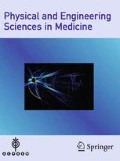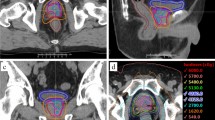Abstract
Prostate cases commonly consist of dual phase planning with a primary plan followed by a boost. Traditionally, the boost phase is planned independently from the primary plan with the risk of generating hot or cold spots in the composite plan. Alternatively, boost phase can be planned taking into account the primary dose. The aim of this study was to compare the composite plans from independently and dependently planned boosts using dosimetric and radiobiological metrics. Ten consecutive prostate patients previously treated at our institution were used to conduct this study on the Raystation™ 4.0 treatment planning system. For each patient, two composite plans were developed: a primary plan with an independently planned boost and a primary plan with a dependently planned boost phase. The primary plan was prescribed to 54 Gy in 30 fractions to the primary planning target volume (PTV1) which includes prostate and seminal vesicles, while the boost phases were prescribed to 24 Gy in 12 fractions to the boost planning target volume (PTV2) that targets only the prostate. PTV coverage, max dose, median dose, target conformity, dose homogeneity, dose to OARs, and probabilities of benefit, injury, and complication-free tumor control (P+) were compared. Statistical significance was tested using either a 2-tailed Student’s t-test or Wilcoxon signed-rank test. Dosimetrically, the composite plan with dependent boost phase exhibited smaller hotspots, lower maximum dose to the target without any significant change to normal tissue dose. Radiobiologically, for all but one patient, the percent difference in the P+ values between the two methods was not significant. A large percent difference in P+ value could be attributed to an inferior primary plan. The benefits of considering the dose in primary plan while planning the boost is not significant unless a poor primary plan was achieved.


Similar content being viewed by others
References
http://seer.cancer.gov/statfacts/html/prost.html Accessed 28 Jan 2016
Pollack A, Zagars GK, Starkschall G, Antolak JA, Lee JJ, Huang E, Von Eschenbach AC, Kuban DA, Rosen I (2002) Prostate cancer radiation dose response: results of the MD Anderson phase III randomized trial. Int J Radiat Oncol Biol Phys 53(5):1097–1105
Budäus L, Bolla M, Bossi A, Cozzarini C, Crook J, Widmark A, Wiegel T (2012) Functional outcomes and complications following radiation therapy for prostate cancer: a critical analysis of the literature. Eur Urol 61(1):112–127
Alicikus ZA, Yamada Y, Zhang Z, Pei X, Hunt M, Kollmeier M, Cox B, Zelefsky MJ (2011) Ten-year outcomes of high-dose, intensity-modulated radiotherapy for localized prostate cancer. Cancer 117(7):1429–1437
Mavroidis P, Lind BK, Brahme A (2001) Biologically effective uniform dose (D) for specification, report and comparison of dose response relations and treatment plans. Phys Med Biol 46(10):2607
Mavroidis P, Lind BK, Van Dijk J, Koedooder K, De Neve W, De Wagter C, Planskoy B, Rosenwald JC, Proimos B, Kappas C, Danciu C (2000) Comparison of conformal radiation therapy techniques within the dynamic radiotherapy project ‘Dynarad’. Phys Med Biol 45(9):2459
Kallman P, Lind BK, Brahme A (1992) An algorithm for maximizing the probability of complication-free tumour control in radiation therapy. Phys Med Biol 37(4):871
Lind BK, Mavroidis P, Hyödynmaa S, Kappas C (1999) Optimization of the dose level for a given treatment plan to maximize the complication-free tumor cure. Acta Oncol 38(6):787–798
Martinez AA, Krauss DJ, Hsu IC, Morton G, Bruner DW, Movsas B, Elshaikh M (2011) Radiation therapy oncology group RTOG 0815 a phase III prospective randomized trial of dose-escalated radiotherapy with or without short-term androgen deprivation therapy for patients with intermediate-risk prostate cancer. https://www.rtog.org/ClinicalTrials/ProtocolTable/StudyDetails.aspx?study=0815. Accessed 11 Jan 2011
Ågren A, Brahme A, Turesson I (1990) Optimization of uncomplicated control for head and neck tumors. Int J Radiat Oncol Biol Phys 19(4):1077–1085
Källman P, Ågren A, Brahme A (1992) Tumour and normal tissue responses to fractionated non-uniform dose delivery. Int J Radiat Biol 62(2):249–262
Tzikas A, Karaiskos P, Papanikolaou N, Sandilos P, Koutsouveli E, Lavdas E, Scarleas C, Dardoufas K, Lind BK, Mavroidis P (2011) Investigating the clinical aspects of using CT vs. CT-MRI images during organ delineation and treatment planning in prostate cancer radiotherapy. Technol Cancer Res Treat 10(3):231–242
R Development Core Team (2008) R: a language and environment for statistical computing. R Foundation for Statistical Computing, Vienna. ISBN 3-900051-07-0
Mavroidis P, Lind BK, Baltas D, Papanikolaou N (2011) Use of radiobiological modeling in treatment plan evaluation and optimization of prostate cancer radiotherapy. INTECH Open Access Publisher, Offenbach
Brahme A (1984) Dosimetric precision requirements in radiation therapy. Acta Oncol 23(5):379–391
Niemierko A (1997) Reporting and analyzing dose distributions: a concept of equivalent uniform dose. Med Phys 24(1):103–110
Mavroidis P, Axelsson S, Hyödynmaa S, Rajala J, Pitkänen MA, Lind BK, Brahme A (2002) Effects of positioning uncertainty and breathing on dose delivery and radiation pneumonitis prediction in breast cancer. Acta Oncol 41(5):471–485
Acknowledgments
The authors would like to acknowledge the assistance from Patricia Candia, Ph.D. in proof-reading the manuscript and giving valuable feedback.
Author information
Authors and Affiliations
Corresponding author
Rights and permissions
About this article
Cite this article
Narayanasamy, G., Avila, G., Mavroidis, P. et al. Comparison of composite prostate radiotherapy plan doses with dependent and independent boost phases. Australas Phys Eng Sci Med 39, 727–733 (2016). https://doi.org/10.1007/s13246-016-0469-3
Received:
Accepted:
Published:
Issue Date:
DOI: https://doi.org/10.1007/s13246-016-0469-3




